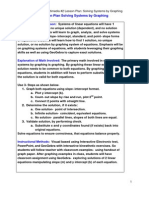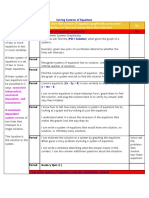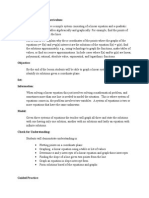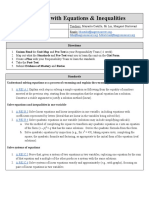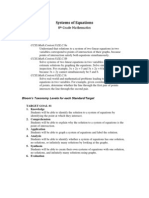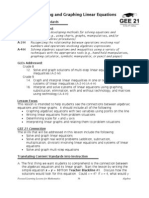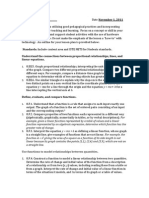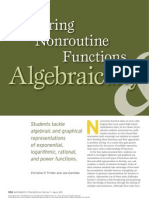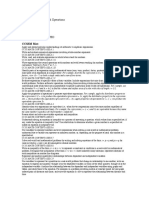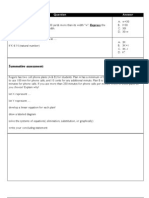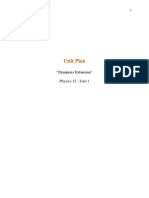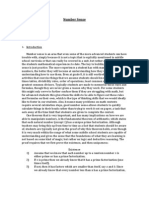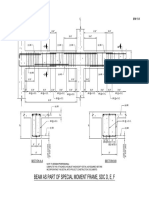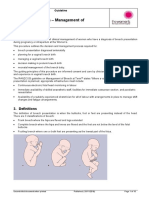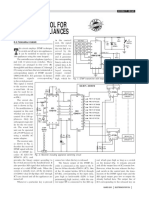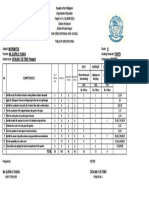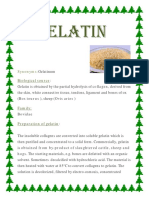Collection of Lesson Plans
Collection of Lesson Plans
Uploaded by
api-231033473Copyright:
Available Formats
Collection of Lesson Plans
Collection of Lesson Plans
Uploaded by
api-231033473Original Title
Copyright
Available Formats
Share this document
Did you find this document useful?
Is this content inappropriate?
Copyright:
Available Formats
Collection of Lesson Plans
Collection of Lesson Plans
Uploaded by
api-231033473Copyright:
Available Formats
Collection of Lesson Plans
Foundation and Pre-calculus Mathematics Grade 10 (Unit 7) Introduction, 2 Consecutive Lesson Plans (7.1 & 7.2), Unit Test & Answer Sheet
Page. 2
Material: Chalkboard or Whiteboard SMARTboard with internet access, graphing calculator, web-based/downloadable graphing programs (e.g. Sketchpad). New vocabulary: A System of linear equations Linear system Solving by Substitution or Elimination Infinite Coincident lines. Main Ideas: 1. Graph a linear equation with x and y- intercepts. 2. Graph a linear equation with slope and y-intercept. 3. Write a slope/ intercept format (y=mx+b) of linear equation by using slope and yIntercept. 4. How to convert slope/Intercept format of equation to standard form (ax+by+c=0) or vice versa. 5. Explore a graphing calculator and show them how to use it for graphing. 6. Introduce a system of linear equations. 7. Write a system of linear equations for a word-type task/problem that has two variables. 8. Solve a system of linear equations by graphing (on the board, or using a graphing calculator.) 9. Solve a system of linear equations by substitution strategy. 10. Solve a system of linear equations by elimination strategy. 11. How to choose a method to solve a system of linear equations. (Explain to students when and why to use a certain strategy). 12. Explain why sometimes there is no solution for a system of linear equations (graphing parallel lines), and why there is an infinite solution (when lines are coincide on each other) for some linear system of equations. 13. Provide a number of what-if questions to get students involve in their learning. 14. Perform an informal formative assessment to address the wording question that related to the last 2 questions of unit test. I explain how to decode the question and how to form the 2 linear equations accordingly. For instance, for Question No. 14 we can decode the question as follows: A+B=16, BA = AB-18, where AB = 10A+B and so BA = 10B+A, and students can solve this system of linear equations with one of the strategies.) 15. Perform a unit test (according to the attached unit test and answer sheet) (Create Custom Pre-Algebra, Algebra 1, Algebra 2, and Geometry Worksheets, 2012) Introduction: In this unit (Unit 7, pages 394-444 of Grade 10 Mathematic textbook) we are concentrating on modeling problems (tasks) by using linear relationship and graphing linear equations that we learned in unit 6. Interaction with students throughout the lesson is the best way to direct my classroom. I have used the bold font in this section whenever I have paused and asked my students to participate.
Page. 3
We are using two methods of graphing and algebra strategies to solve two linear equations. Solving a linear equation with one variable (e.g. x+5=7) means to find an x that satisfies this expression. When we have two unknown variables we also need two linear equations to find the ordered pair (x,y) that satisfies both equations. (e.g. x-y =3 and y=2x+1). A system of linear equations may have one solution, infinite solution or no solution at all. When a system of linear equations has only one ordered pairs of (x,y) we use the mathematical term point of intersection of two lines or two equations. No matter what strategy we apply we should always get one definite solution. There are some instances when we graph both equations and we notice that they are parallel or in another words they both have the same slope and we already know that parallel lines have no intersections or mathematically we say no solution . For these instances we are not able to find an ordered pair that satisfies both equations. Finally, there are some unique situations that both equations have same slope and same y intercept (a point that graph cuts the y axis), (e.g. x+y=2 and 5y=2-5x) once we graph these pair of equations we see that both graph coincide each other. In another words all the point on the graph are the solutions. Mathematical term for this situation is infinite answer. 1. Developing Systems of Linear Equations: A linear equation can be written in two forms of where b is the y intercept and m is the slope, or , it is recommended to reform the second form to the slope-intercept format and solve for y. This will help us to graph the equation in lesser time. ( ( ) ( ) ) ( )
2. Solving a Systems of Linear Equations Graphically There are number of task we can use to direct the classroom to the idea of this lesson, I usually try to give examples that students are familiar or it has some real life connection that they can relate the topic of this lesson to it. Task We are going to tile our kitchen and we know that perimeter is 12m2. We know that our kitchen is rectangular shape and the length is twice as width. Then, we ask students to translate this problem in algebraic expressions and see if they can find the width and length of the kitchen. Student can guess and find the right answer to this problem but we are going to solve this task more strategically than just guessing. The attached lesson plan (7.1) thoroughly explains how we can solve this kind of problem by graph. We basically translate ) the perimeter of 12 into [ ( . And once we graph both equation by using slope-intercept method we come to the only solution of (2, 4). 3. Using an Elimination Strategy to Solve a Systems of Linear Equations Given the same task we can use elimination method. We know that we can divide, multiply, add, subtract both side of an equation by none zero coefficient (Why?). We build this elimination strategy on this fact and we eliminate either x or y on both equation and we solve the remaining terms algebraically since one equation with one variable is solvable, why? Once we find one variable we easily substitute the known value and we solve for the 2nd variable. This is method is pure algebraically and does
Page. 4
not use any graphing technique and recommended for those student that have difficulty using graph. 4. Using Substitution Strategy to solve a Systems of Linear Equations Substitution method is self-explanatory strategy and we basically substitute x or y from one equation to the other one. I suggest use this method only if one of the equation is in slope-intercept format or in another word whenever x or y has coefficient one. Once again this method is constructed algebraically and we solve a system in 3 steps: First, we substitute one of the variables on the 2nd equation. Second, we solve the single variable equation (2nd equation). Third, we put this value to the one f the equation (I usually ask my student at this point to choose the best equation and ask them to explain me why they decided to choose equation 1 or 2). Student-student discussion, student-teacher interaction is very important especially when it comes to routine algebra procedures. I make sure to get my student involve as much as possible. Pause and question frequently to make sure they are following my path. It is good to provide them with some unique and provocative situations. Like parallel lines or when they are using the elimination strategy they will face a situation where both x and y get eliminated, and then ask them to explain what has happened? How do we find the answer? Or is there any answer at all? Summary: Lessons 7.1 and 7.2 basically have covered the whole framework of unit 7. Lesson 7.1 can be divided into 2-3 consecutive plans as it covers the main ideas from 1 to 7 as listed above, and lesson 7.2 can be divided into 2 consecutive lessons one for Substitute method and one for Elimination method for unit main ideas from 8 to 15. References: 1. Create Custom Pre-Algebra, Algebra 1, Algebra 2, and Geometry Worksheets. (2012). Retrieved November 19, 2012, from http://www.kutasoftware.com/
You might also like
- A Detailed Lesson Plan in Graphing Systems of Linear InequalitiesDocument4 pagesA Detailed Lesson Plan in Graphing Systems of Linear InequalitiesGlenn Ford Bayongasan Bacgalang100% (6)
- Lesson Plan Linear EquationsDocument5 pagesLesson Plan Linear Equationsapi-283691486100% (1)
- Origins of The Greek Architectural OrdersDocument240 pagesOrigins of The Greek Architectural Orderskraus leonardNo ratings yet
- Safety PosterS P I Club PDFDocument24 pagesSafety PosterS P I Club PDFAamir SirohiNo ratings yet
- Chapter 1 Wellness Fitness and Lifestyle Management PDFDocument26 pagesChapter 1 Wellness Fitness and Lifestyle Management PDFiam_crazii_4_mheNo ratings yet
- LessonsDocument4 pagesLessonsapi-231033473No ratings yet
- Assessment Project of RecordDocument19 pagesAssessment Project of Recordapi-208358319No ratings yet
- Final Project of Record AssessmentDocument29 pagesFinal Project of Record Assessmentapi-208358319No ratings yet
- Lesson Plans 1-26 Through 1-30Document5 pagesLesson Plans 1-26 Through 1-30api-246024051No ratings yet
- Learning Experience Plan (Day 1)Document12 pagesLearning Experience Plan (Day 1)api-341064475No ratings yet
- lp2 - Systems of Equations Their SolutionsDocument7 pageslp2 - Systems of Equations Their Solutionsapi-353551219No ratings yet
- Teaching MathematicDocument6 pagesTeaching MathematicmaeselasekgaolelaNo ratings yet
- 3x3 Linear Systems of Equations TeacherDocument7 pages3x3 Linear Systems of Equations TeacherDenise ParksNo ratings yet
- Lesson Plan Solving Systems by GraphingDocument12 pagesLesson Plan Solving Systems by Graphingyusi rizaNo ratings yet
- Ubd Lesson Plan 3 25 14Document2 pagesUbd Lesson Plan 3 25 14api-253299522No ratings yet
- Solving Sle by Graphing MethodDocument21 pagesSolving Sle by Graphing Methodapi-313517608No ratings yet
- I Can Solve Systems of Equations Graphically ViaDocument1 pageI Can Solve Systems of Equations Graphically Viaapi-297021169No ratings yet
- Lesson Plan 4Document5 pagesLesson Plan 4api-337699623100% (1)
- Lessonplans 2Document16 pagesLessonplans 2api-341209699No ratings yet
- Solving Linear EquationsDocument4 pagesSolving Linear Equationsapi-150547803No ratings yet
- General Instructional Lesson Plan FormatDocument4 pagesGeneral Instructional Lesson Plan Formatmrs_haynesNo ratings yet
- Equation of Straight LineDocument22 pagesEquation of Straight LineIrma Rizuana Yaakub100% (3)
- Systems of Equations-EliminationDocument6 pagesSystems of Equations-Eliminationapi-321443899No ratings yet
- Solve System of EquationsDocument4 pagesSolve System of Equationsapi-174648067No ratings yet
- Methods Unit PlanDocument3 pagesMethods Unit Planapi-532857042No ratings yet
- Tel311 Lesson VisionDocument2 pagesTel311 Lesson Visionapi-296195201No ratings yet
- 8th Math Curriculum MapDocument7 pages8th Math Curriculum Mapapi-261608473No ratings yet
- Advanced AlgebraDocument20 pagesAdvanced AlgebraRems RecablancaNo ratings yet
- Exponential FunctionsDocument7 pagesExponential FunctionshneddoNo ratings yet
- CcssDocument5 pagesCcssapi-237229475No ratings yet
- LP Points As TestersDocument5 pagesLP Points As Testersapi-251578516No ratings yet
- Reasoning With Equations Inequalities Unit MapDocument2 pagesReasoning With Equations Inequalities Unit Mapapi-343090158No ratings yet
- How To Solve EquationsDocument4 pagesHow To Solve Equationsapi-150547803No ratings yet
- Precalculus-Q1-W6-Module 9Document16 pagesPrecalculus-Q1-W6-Module 9mikomira21No ratings yet
- LessonplansequenceDocument32 pagesLessonplansequenceapi-341108813No ratings yet
- Graphing Linear EquationsDocument12 pagesGraphing Linear EquationsJen GoldschmidtNo ratings yet
- Las Q2 Mathematics8 SirtwoDocument16 pagesLas Q2 Mathematics8 Sirtwokarlajean bongatoNo ratings yet
- 8.ee.7unit PlanDocument13 pages8.ee.7unit PlanChris DelawareNo ratings yet
- Bloomstaxonomy Systems of EquationsDocument2 pagesBloomstaxonomy Systems of Equationsapi-208358319No ratings yet
- Learning Area Mathematics Learning Delivery Modality Synchronous Learning/Online Modular/Printed ModularDocument8 pagesLearning Area Mathematics Learning Delivery Modality Synchronous Learning/Online Modular/Printed ModularNeo Banayo VillarealNo ratings yet
- Lesson Planning Quadratic & LinearDocument1 pageLesson Planning Quadratic & LinearJonathan RobinsonNo ratings yet
- Midterm Exam Review GuideDocument4 pagesMidterm Exam Review GuidexneoNo ratings yet
- College and Adavnced Algebra Final ModuleDocument12 pagesCollege and Adavnced Algebra Final ModuleMary May C. MantoNo ratings yet
- U9l5 - Systems of Linear and Quadratic Equations Lesson PlanDocument2 pagesU9l5 - Systems of Linear and Quadratic Equations Lesson Planapi-242122700No ratings yet
- Henderson System of Inequalities Introduction - 9th GradeDocument10 pagesHenderson System of Inequalities Introduction - 9th Gradeapi-297435304No ratings yet
- Algebra AnswersDocument4 pagesAlgebra Answersapi-150547803No ratings yet
- Chapter - 4 Linear Equations in Two VariablesDocument15 pagesChapter - 4 Linear Equations in Two VariablesRAJIV SHARMANo ratings yet
- Digital Unit Plan TemplateDocument3 pagesDigital Unit Plan Templateapi-238888318No ratings yet
- Quadratic UnitDocument63 pagesQuadratic Unitapi-250717764No ratings yet
- Lesson 4: Solving and Graphing Linear Equations: Focused Learning Lessons For Mathematics AlgebraDocument14 pagesLesson 4: Solving and Graphing Linear Equations: Focused Learning Lessons For Mathematics AlgebraandhodgeNo ratings yet
- Slope InterceptDocument10 pagesSlope InterceptIzzy Joseph ZetinaNo ratings yet
- General Mathematics: Quarter 1 - Module 1 FunctionsDocument17 pagesGeneral Mathematics: Quarter 1 - Module 1 FunctionscykenNo ratings yet
- How To Solve An EquationDocument6 pagesHow To Solve An Equationapi-126876773No ratings yet
- 1 3. EquationsDocument3,741 pages1 3. EquationsRoss HamiltonNo ratings yet
- Day 3Document5 pagesDay 3Bethani ScottNo ratings yet
- Exploring Nonroutine FunctionsDocument6 pagesExploring Nonroutine Functionsapi-21940065No ratings yet
- MathDocument35 pagesMathbritaniaNo ratings yet
- College Algebra Tutorial 21: Absolute Value EquationsDocument9 pagesCollege Algebra Tutorial 21: Absolute Value Equationssalman saeedNo ratings yet
- Edmt Project 3 Lesson PlanDocument6 pagesEdmt Project 3 Lesson Planapi-239725661No ratings yet
- Unit Plan: Numbers and Operations Grade Level: Fifth Lessons Presented: 17 Resources Provided: TBD CCSSM MetDocument10 pagesUnit Plan: Numbers and Operations Grade Level: Fifth Lessons Presented: 17 Resources Provided: TBD CCSSM Metapi-243809172No ratings yet
- Identify Desired Results (Stage 1) Content StandardsDocument9 pagesIdentify Desired Results (Stage 1) Content Standardsapi-283548263No ratings yet
- Algebra II Standards Final ChartDocument6 pagesAlgebra II Standards Final Chartapi-273248611No ratings yet
- ReferencesDocument1 pageReferencesapi-231033473No ratings yet
- Word ProblemsDocument2 pagesWord Problemsapi-231033473No ratings yet
- Rubric For Word ProblemsDocument2 pagesRubric For Word Problemsapi-231033473100% (1)
- PosterDocument1 pagePosterapi-231033473No ratings yet
- Unit PlanDocument34 pagesUnit Planapi-231033473No ratings yet
- Dan - ProbabilityDocument5 pagesDan - Probabilityapi-231033473No ratings yet
- Dan - Number SenseDocument6 pagesDan - Number Senseapi-231033473No ratings yet
- Dan - Patterns and RelationsDocument5 pagesDan - Patterns and Relationsapi-231033473No ratings yet
- Royal Industries All BrochureDocument24 pagesRoyal Industries All Brochurekhanindra07No ratings yet
- Effects of Long-Term Computer Use On Eye DrynessDocument4 pagesEffects of Long-Term Computer Use On Eye DrynessMuhammad Farhan KurniawanNo ratings yet
- BEGO Implant Systems Product Catalogue 2015-2016 PDFDocument179 pagesBEGO Implant Systems Product Catalogue 2015-2016 PDFAlvaro RivCalleNo ratings yet
- A320 Technical NotesDocument118 pagesA320 Technical NotesMiran Mir0% (1)
- 645-Article Text-3548-1-10-20211216Document7 pages645-Article Text-3548-1-10-20211216Mr.aup KamalNo ratings yet
- Dot 192 Full StandardDocument133 pagesDot 192 Full StandardWilmer EgeaNo ratings yet
- Beam DetailsDocument3 pagesBeam DetailsShahidHamkarNo ratings yet
- A Computational Fluid Dynamics Model For Investigating Air Flow Patterns in Underground Coal Mine SectionsDocument7 pagesA Computational Fluid Dynamics Model For Investigating Air Flow Patterns in Underground Coal Mine SectionsJaponec PicturesNo ratings yet
- Pediatric CVS Exam: 2015/2016 Mohamad-Hani Temsah, M.DDocument24 pagesPediatric CVS Exam: 2015/2016 Mohamad-Hani Temsah, M.Dعلي. احمدNo ratings yet
- Clinical Diagnosis and Therapy of Colorectal CancerDocument110 pagesClinical Diagnosis and Therapy of Colorectal CancerRizal Sven VollfiedNo ratings yet
- Breech - Management Of: 1. PurposeDocument15 pagesBreech - Management Of: 1. PurposeMuathNo ratings yet
- 02 - Sikorsky BLACK HAWK Argentina - AES v7Document29 pages02 - Sikorsky BLACK HAWK Argentina - AES v7pedroNo ratings yet
- Eswd AssignmentDocument10 pagesEswd AssignmentArslan MansooriNo ratings yet
- Hydraulic Power AssistDocument26 pagesHydraulic Power AssistPradeep Kumar MehtaNo ratings yet
- Information MSQ KROK 2 Medicine 2007 2021 PEDIATRICSDocument112 pagesInformation MSQ KROK 2 Medicine 2007 2021 PEDIATRICSReshma Shaji PnsNo ratings yet
- Mr. M. Shiva Nandha ReddyDocument71 pagesMr. M. Shiva Nandha Reddyd kumarNo ratings yet
- Lesson PlanDocument12 pagesLesson Planjmode001No ratings yet
- 2nd Semister Examination Sample - 050216Document1 page2nd Semister Examination Sample - 050216Rakib ChowdhuryNo ratings yet
- King Off-Road Racing Shock Rebuild and Revalve InstructionsDocument7 pagesKing Off-Road Racing Shock Rebuild and Revalve InstructionsAnonymous wpUyixsjNo ratings yet
- Chapter 10 Electrical System: ContentDocument19 pagesChapter 10 Electrical System: ContentFabian Carrasco NaulaNo ratings yet
- Nursing TheoryDocument12 pagesNursing TheorybldewnaNo ratings yet
- Datasheet Quikcoup 08T 08GDocument1 pageDatasheet Quikcoup 08T 08GJustin ReyesNo ratings yet
- Testing English Language Reading & WritingDocument22 pagesTesting English Language Reading & WritingminhankyawNo ratings yet
- West A New History Volume One The Anthony Grafton & David A. Bell All Chapter Instant DownloadDocument34 pagesWest A New History Volume One The Anthony Grafton & David A. Bell All Chapter Instant DownloadadycphatiNo ratings yet
- Keypad Control For Multiple Appliances: S. Ramasamy R.G.Thiagaraj KumarDocument2 pagesKeypad Control For Multiple Appliances: S. Ramasamy R.G.Thiagaraj KumarSuper WhippedNo ratings yet
- TOS Math 10Document1 pageTOS Math 10Ma Gloria Deocades FlanciaNo ratings yet
- Gelatin - Alfida PDFDocument3 pagesGelatin - Alfida PDFalfidaNo ratings yet













